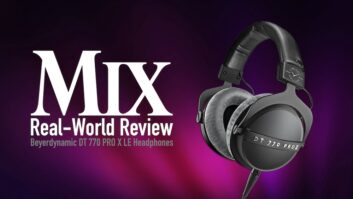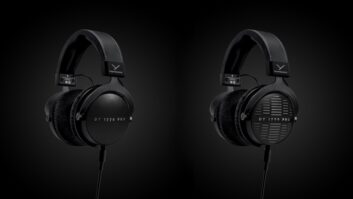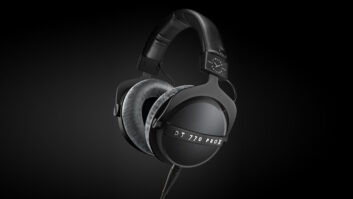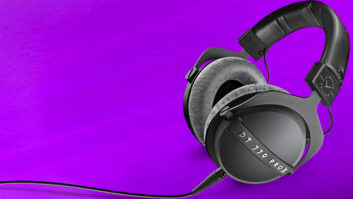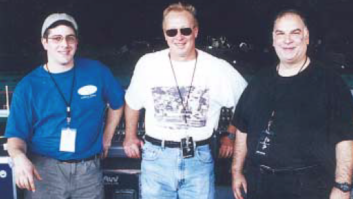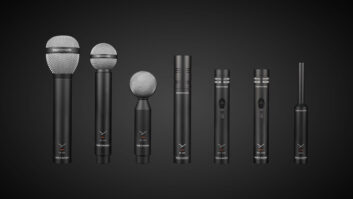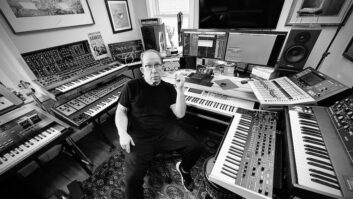Opus 69
Beyerdynamic’s latest performance mics are the Opus 69 and the Opus
81. The $299 69 is a supercardioiddynamic intended for live sound
applications, ranging from vocals to miking instruments and cabinets.
The $425 81 cardioid condenser (back electret) is equally usable
onstage and in the studio for vocals and acoustic instruments. The mics
offer a black matte finish, sleek styling and rugged construction,
built to endure long outings on the road; both include mic clips and
padded carry bags.
THE OPUS 69
Boasting a respectable frequency response of 35 to 16k Hz, the 69 was a
solid performer in live sound situations. On vocals, I set up the 69
for the lead vocalist in a local rock band. With a full P.A. and live
drums, I A/B’d between the 69 and the SM58s that we normally use. The
first thing I noticed was the level difference and the clarity; I
normally spend a good amount of time fighting with the gain and the EQ
to get the lead vocal to cut through. With the 69’s noticeably higher
output and excellent rejection, I could back the gain way off while
preserving a great-sounding signal. The 69 produces a pronounced
mid-range boost that provides a bright sound without requiring EQ. All
of this yields a very clear and easy-to-use signal.
The 69’s extremely tight pattern does wonders to reduce leakage, but
performers who sing while playing or moving around a lot should get
acquainted with this mic before going onstage. In my studio, I set up
the 69 for some demo work and tracked my own vocals and a direct guitar
line. In playing back the material (without adding compression), I
noticed substantial level differences in my vocals on each of the more
difficult chord changes where I was turning my head. After a few
run-throughs, I was used to the 69’s pattern—this tight,
supercardioid response is something performers need to know about
before using this mic.
On acoustic guitar, the 69 seemed an obvious choice. On a boom stand
positioned approximately 10 inches from the performer, the 69 sounded
great—clear, uncluttered, full and warm. The same applied to
guitar and bass cabinets; the 69 rocked on both a Fender Princeton and
a Peavey TNT bass amp. The mic had no trouble with high SPLs, and
its handling of heavily effected guitar tones was exactly what one
would expect from a mic of this caliber.
Opus 81
THE OPUS 81
The Opus 81 has a stated frequency response of 50 to 18k Hz and a max
SPL of 138 dB. The capsule is fitted with a tight mesh
covering, which doubles as an internal pop screen and protective cover
to keep saliva and dirt out of the condenser element.
On lead vocals, the 81 sounded like a happy medium between a
high-end dynamic and mid-level studio condenser. It didn’t quite have
the warmth, character or features of, say, a RØDE NT-2, but it
sounded noticeably fuller and richer than any of the dynamics I paired
it against. This mic would be an especially good fit for younger
performers, quieter singers, and softer, more nuanced performances. The
mic’s internal pop screen was fairly resistant to plosives, and the 81
had almost no handling noise.
I also tried the 81 on guitar and violin in the studio, and the mic
continued to impress me, providing the kind of clear, pristine signal
that you almost don’t want to touch. On guitar, the 81’s response was
flat and predictable, with the performer positioned six to 12 inches
away and even swaying around a bit. With the violin, I felt the need to
keep the performer on the mic a little tighter, but, again, the 81
provided a realistic and uncolored signal.
CONCLUSIONS
For performers who play in less-than-ideal locales, where the mic
selection leaves something to be desired, a complement of Opus 69s for
your vocalists will do wonders to improve your overall sound. The Opus
81 could be a dream come true for performers working pro venues where
phantom power is available. These are two mics
that you’ll definitely hear the difference.
Beyerdynamic, www.beyerdynamic.com
